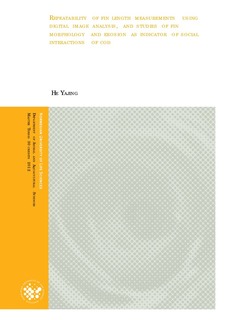| dc.contributor.author | He, Yajing | |
| dc.date.accessioned | 2012-09-20T12:36:43Z | |
| dc.date.available | 2012-09-20T12:36:43Z | |
| dc.date.copyright | 2012 | |
| dc.date.issued | 2012-09-20 | |
| dc.identifier.uri | http://hdl.handle.net/11250/186165 | |
| dc.description | This master thesis is part of the BreedWell project, aiming to developing methods to improve fish welfare in aquaculture breeding programs. The project is run by the Norwegian Institute of Food, Fisheries and Aquaculture Research (Nofima) and funded by the Research Council of Norway. This study was carried out at Nofima Marin, over the period from December 2011 to August 2012.
Animal welfare is a subject of increasing interest for ethical and legal reasons. Various traits can be used as indicators of animal welfare. For selection and breeding purposes, it has been shown that the trait frequency of injury (e.g. fin damage) can be taken into account in fish selective breeding and have generally been used in cannibalistic fish species such as rainbow trout. However, evidence related to the fin condition of the Atlantic cod is lacking. I believe this study relating to fin morphology and changes in cod will provide useful knowledge for making logical and meaningful inferences of the cause of fin damage due to possible social interactions (or cannibalism) among conspecifics.
Changes in fin length, is one of the methods commonly used to assess the degree of fin damage. Differing from normal methods of measuring fish length, we use digital image analysis to measure fin length of fish in this study which showed the advantage of being convenient and time-saving. Assessor reliability test indicated that it was feasible to record fin length using digital image analysis which further proved its accuracy in measurements. I suggest that more advanced and sophisticated technologies ought to be applied in research studies with various purposes to speed up the development of scientific industry in the future. | no_NO |
| dc.description.abstract | Fin damage, commonly termed as fin erosion, has been paid considerable attention as a worldwide welfare issue especially in cannibalistic fish species. As cannibalistic fish, Atlantic cod (Gadus morhua) has been showed to have fin damage. The present study was conducted with 2100 juvenile cod with a mean initial body weight of 34.6g. The lengths of four fins (three dorsal and the caudal) for each fish were measured, and the measurements were made by three different assessors at three different points of time (recording 1-3) within six weeks of the experiment. This paper demonstrates the application of digital image analysis for analyzing fin length of cod. In order to provide an indication of the repeatability of digital image analysis, a reliability test was performed. The image of 42 randomly chosen juvenile cod taken at recording 3 was analyzed repeatedly by three different assessors. Significant differences in fin length measurements were found both between and within assessors. However the Pearson’s correlation in fin length measurements between each of the two assessor replicates was equal to or higher than 0.45. There were moderate correlations of fin length measurements between different assessors (r=0.45-0.84), and the correlations between replicates within same assessor were strong (r=0.57-0.94). In addition, majority of the variance was found to be attributed to the fish effect rather than assessor effect. Generally there were moderate repeatability of the fin lengths analyzed using digital image (R=0.46-0.61). With the support of all the statistical results from the reliability test, it is justified to say that this digital image based approach to measure fin length is accurate and feasible for genetic analyses.
All the data set obtained from 2100 juvenile cod was used to assess the changes for all four fins during the experiment due to growth or possible erosion. “Relative fin length” expressed as the percentage of fin length to the total body length, was applied in this study to assess the fin erosion. All four fins of fish suffered damages within the first two weeks (recording 1-2), and the caudal fin showed the most injury. In the following four weeks until the end of the experiment (recording 2-3), the cannibalism diminished with anterior dorsal fin still suffering degeneration. Later the incidence of fin erosion also reduced compared to that described for the first two weeks of the experiment. In general, the damage was concentrated on anterior dorsal and caudal parts of the fish. A possible hypothesis is that the fin erosion was probably due to attacks among the cohorts in the same rearing unit for the establishment of dominance hierarchy (i.e., social interactions). More relevant research is however needed to understand the underlying reasons that may explain the observed fin damage. | no_NO |
| dc.language.iso | eng | no_NO |
| dc.publisher | Norwegian University of Life Sciences, Ås | |
| dc.subject | Atlantic cod Gadus morhua | no_NO |
| dc.subject | digital image analysis | no_NO |
| dc.subject | fin erosion | no_NO |
| dc.subject | fin length measurement | no_NO |
| dc.subject | reliability test | no_NO |
| dc.title | Repeatability of fin length measurements using digital image analysis, and studies of fin morphology and erosion as indicator of social interactions of cod | no_NO |
| dc.title.alternative | Gjentaksgrad av målinger av finnelengde gjennomført ved hjelp av digitale bildeanalyser, og studier av finnemorfologi og -erosjon som indikatorer for sosiale interaksjoner mellom torsk i oppdrett | no_NO |
| dc.type | Master thesis | no_NO |
| dc.subject.nsi | VDP::Agriculture and fishery disciplines: 900::Fisheries science: 920::Aquaculture: 922 | no_NO |
| dc.source.pagenumber | 57 | no_NO |
